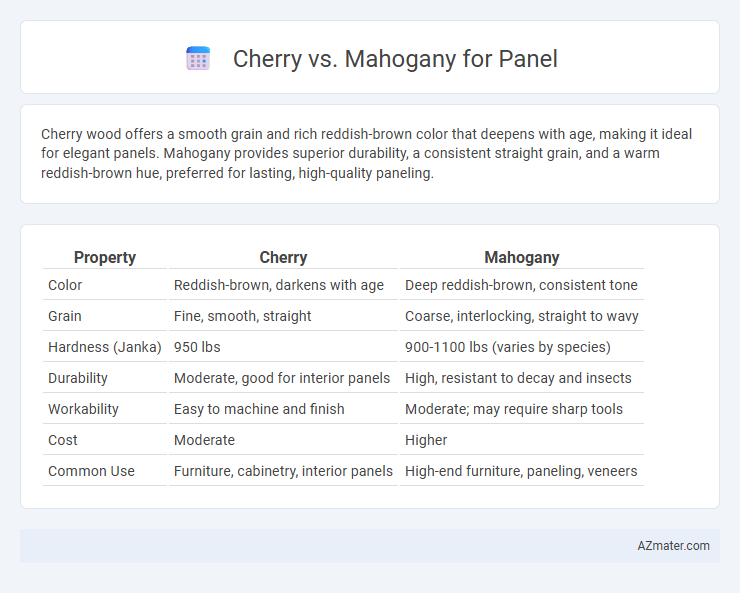Cherry wood offers a smooth grain and rich reddish-brown color that deepens with age, making it ideal for elegant panels. Mahogany provides superior durability, a consistent straight grain, and a warm reddish-brown hue, preferred for lasting, high-quality paneling.
Table of Comparison
| Property | Cherry | Mahogany |
|---|---|---|
| Color | Reddish-brown, darkens with age | Deep reddish-brown, consistent tone |
| Grain | Fine, smooth, straight | Coarse, interlocking, straight to wavy |
| Hardness (Janka) | 950 lbs | 900-1100 lbs (varies by species) |
| Durability | Moderate, good for interior panels | High, resistant to decay and insects |
| Workability | Easy to machine and finish | Moderate; may require sharp tools |
| Cost | Moderate | Higher |
| Common Use | Furniture, cabinetry, interior panels | High-end furniture, paneling, veneers |
Introduction to Cherry and Mahogany Wood
Cherry wood is prized for its rich, reddish-brown color that deepens with age, fine grain, and smooth texture, making it a popular choice for elegant paneling and furniture. Mahogany, known for its deep reddish-brown to dark brown hues, offers exceptional durability, straight grain, and resistance to decay, making it ideal for high-end cabinetry and paneling applications. Both woods provide distinct aesthetic and structural qualities, with cherry delivering warmth and refinement, while mahogany emphasizes strength and longevity.
Botanical Origins and Species Differences
Cherry wood originates from the Prunus genus, primarily from the American Black Cherry (Prunus serotina), known for its fine, straight grain and warm reddish-brown hue. Mahogany commonly refers to hardwoods from the Swietenia genus, especially Swietenia macrophylla, featuring a coarse, interlocking grain and a rich, deep reddish-brown color. Species differences affect hardness, grain pattern, and resin content, influencing panel durability and aesthetic appeal in woodworking projects.
Grain Patterns and Aesthetic Appeal
Cherry wood features a smooth, fine grain with rich reddish-brown hues that deepen over time, making it highly valued for elegant paneling. Mahogany boasts a straight, interlocking grain with a deep, warm reddish-brown color, often displaying striking figure patterns like ribbon or flame grain. Both woods provide stunning visual appeal, but Cherry's subtle grain and warm patina contrast with Mahogany's bold, dramatic texture, influencing design preference in interior panel applications.
Color and Aging Characteristics
Cherry wood exhibits a rich reddish-brown tone that deepens to a warm, reddish patina over time due to exposure to light and air. Mahogany offers a deep, reddish-brown color with a consistent hue that darkens slightly but maintains its rich saturation with age. Both woods enhance a panel's aesthetics through natural aging, but Cherry's color transformation is more pronounced, creating a dynamic visual appeal.
Durability and Hardness Comparison
Cherry wood offers a Janka hardness rating of approximately 950, providing moderate durability and resistance to dents, making it suitable for interior panels with lighter wear. Mahogany, with a higher Janka hardness around 800 to 900 depending on the species, tends to be slightly less hard than some cherry varieties but excels in durability due to its dense, oily grain structure that resists moisture and decay. Both woods perform well in panel applications, but cherry is preferred for a smoother finish and aging characteristics while mahogany is favored for its robust stability and longevity in humid environments.
Workability and Finishing Qualities
Cherry wood offers excellent workability with a smooth grain that allows for easy cutting, shaping, and sanding, making it highly suitable for intricate panel designs. Its finishing qualities include a natural reddish-brown hue that deepens with age and exposure to light, providing a warm and rich appearance that enhances panel aesthetics. Mahogany is also prized for its workability, featuring a straight grain that machines well and sands to a silky texture, while its finishing qualities deliver a deep, rich, and consistent reddish-brown color that resists warping and highlights fine woodworking details in panels.
Cost and Availability
Cherry wood generally costs more than mahogany due to its finer grain and limited supply, making it a premium choice for high-end paneling. Mahogany is more readily available in various grades and sources, often resulting in lower prices and broader accessibility for large projects. Cost differences fluctuate based on geographic location and timber certification, with mahogany offering a more budget-friendly option without compromising durability.
Environmental Impact and Sustainability
Cherry wood is prized for its rich color and fine grain, sourced mainly from sustainably managed hardwood forests in North America, making it a relatively eco-friendly choice when certified by FSC or similar programs. Mahogany, despite its durability and luxurious appearance, often faces criticism due to overharvesting and illegal logging, particularly in tropical regions where deforestation rates remain high. Opting for FSC-certified cherry panels significantly reduces environmental impact, while sourcing mahogany from verified sustainable plantations helps mitigate deforestation and promotes responsible forestry practices.
Common Uses in Paneling Applications
Cherry wood is prized for its rich, warm tones and smooth grain, making it a popular choice for high-end interior paneling in residential and commercial spaces. Mahogany offers exceptional durability and a deep reddish-brown color, often favored in luxury paneling applications such as executive offices, upscale restaurants, and historic restorations. Both woods provide excellent stability and finish quality, but cherry is typically chosen for its contemporary elegance, while mahogany suits classic, formal designs.
Choosing the Best Wood for Your Panels
Cherry wood offers a rich, warm reddish tone and fine grain that deepens with age, making it ideal for elegant, high-end panels. Mahogany provides exceptional durability and a consistent, straight grain with a deep reddish-brown color, perfect for panels requiring strength and a classic look. Choosing the best wood depends on your preference for color evolution and grain pattern versus long-lasting hardness and traditional appeal.

Infographic: Cherry vs Mahogany for Panel
 azmater.com
azmater.com